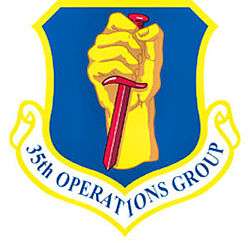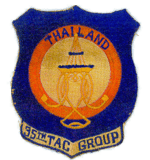35th Operations Group
The 35th Operations Group (35 OG) is the operational flying component of the United States Air Force 35th Fighter Wing. It is stationed at Misawa Air Base, Japan, and is a part of Pacific Air Forces (PACAF).
35th Operations Group
 | |
|---|---|
 Emblem of the 35th Operations Group | |
| Active | 1940–1957; 1963–1965; 1993–1994; 1994–present |
| Country | United States |
| Branch | |
| Type | Fighter |
| Motto(s) | Attack to Defend |
| Engagements |
|
| Commanders | |
| Notable commanders | Edwin A. Doss |


During World War II, the unit's predecessor, the 35th Fighter Group operated primarily in the Southwest Pacific Theater as part of Fifth Air Force, first using P-38s and P-39s, and later P-47s. The group engaged the enemy in numerous campaigns being awarded both the United States Distinguished Unit Citation and the Philippine Presidential Unit Citation.
The group operated from bases in Japan and South Korea during the Korean War, in support of UN ground forces, bombing and strafing enemy supply lines, troop concentrations, and communications, earning a second DUC.
Since the 1990s, the group has deployed aircraft and personnel to Southwest Asia, in support of both the Iraqi no-fly zones (Operations Southern Watch and Northern Watch), and the Global War on Terrorism.
Overview
The 35 OG is a combat-ready fighter group composed of two deployable F-16CJ "Wild Weasel" fighter squadrons (Tail Code: WW), one operational support squadron, and one air control flight capable of conducting and supporting air operations worldwide. Responsible for flight operations, airfield management, intelligence, tactical air control, combat plans, weapons and tactics, and weather support for the 35 FW. The group is assigned the following squadrons:
- 13th Fighter Squadron (Red tail stripe) "Panthers"
- 14th Fighter Squadron (Yellow tail stripe) "Fightin' Samurai"
- 35th Operations Support Squadron
- 610th Air Control Flight
History
- For additional history and lineage, see 35th Fighter Wing
The 35th Pursuit Group (Interceptor) was activated at Moffett Field, California on 1 February 1940. Initial squadrons of the group were the 21st Pursuit Squadron and 34th Pursuit Squadrons. Initially training with Seversky P-35s, P-36 Hawks, P-39 Airacobras, and Curtiss P-40 aircraft, the group moved to the Philippines in November 1941.
World War II
The air echelons of the 21st and 34th Pursuit squadrons arrived in Philippines and were attached to the 24th Pursuit Group, being stationed at Nichols and Del Carmen Fields on Luzon.
Headquarters and a third squadron (70th) sailed for Manila on 5 December but because of the Japanese attack on Pearl Harbor they returned to Hamilton Field where the squadron flew some patrols.
The 21st and 34th Pursuit Squadrons fought in the Battle of the Philippines (1941–42). Both squadrons were wiped out in the battle, with the men eventually fighting as infantry during the Battle of Bataan. The survivors were subjected to the Bataan Death March, although some did escape to Australia.
Headquarters and the 70th squadron sailed for Brisbane, Australia on 12 January 1942. On 15 January all the combat squadrons were relieved and three others, still in the US, were assigned.
Headquarters reached Brisbane Australia in February 1942 while the squadrons had moved from the US to various locations (Ballarat, Mount Gambier, Williamstown, Woodstock) in Australia and were training for combat with P-39s.
From Australia, the 35th entered combat with Fifth Air Force, operating successively from bases in Australia, New Guinea, Owi, Morotai, and the Philippines. First used P-38s and P-39s; equipped with Republic P-47 Thunderbolts late in 1943 and with North American P-51 Mustangs in March 1945. The group helped to halt the Japanese advance in Papua and took part in the Allied offensive that recovered the rest of New Guinea, flying protective patrols over Port Moresby, escorting bombers and transports, attacking Japanese airfields and supply lines, and providing cover for Allied landings.
In 1944 the 35th began long-range missions against enemy airfields and installations in the southern Philippines, Halmahera, and Borneo, preparatory to the US invasion of the Philippines. Beginning in January 1945, operated in support of ground forces on Luzon. Also escorted bombers and completed some fighter sweeps to Formosa and China. Bombed and strafed railways and airfields in Kyūshū and Korea after moving to Okinawa in June 1945.
After the surrender of Japan, the group became part of Far East Air Forces occupation forces and trained, took part in maneuvers, and flew surveillance patrols over Honshū.
Korean War

The 35th entered combat in the Korean War in July 1950, flying F-80s and later F-51s. It operated from bases in Japan and both North and South Korea in support of UN ground forces, bombing and strafing enemy supply lines, troop concentrations, and communications. In August 1950 No. 77 Squadron RAAF was assigned to the 35th Fighter Group for operations during the Korean War. Transferring back to Japan in May 1951, it became non-operational in January–July 1954. It then provided air defense for central Japan until late 1956 but was not operational from October 1956 – October 1957.
Between July 1963 and July 1965, the 35th Tactical Group assisted in training the Royal Thai Air Force and supported and exercised operational control over USAF units and detachments in Thailand assigned or attached to the 2d Air Division.
In an administrative ("paper") realignment in Washington DC in January 1984, the inactive 35th Tactical Group and the inactive 35th Fighter-Interceptor Group were consolidated into one unit. Both remained inactive.
Between May 1993 and October 1994, the resurrected 35th Operations Group managed a fighter (F-15C) and rescue squadron (HH-60G) in Iceland under the 35th Wing. The group activated at Misawa AB, Japan on 1 October 1994, as part of the 35th Fighter Wing, replacing the 432d Fighter Wing and assuming its personnel and F-16C/D aircraft, the same day it inactivated in Iceland. It supported units of the Japanese Air Self Defense Force (JASDF) Northern Air Defense Force. In addition to providing air defense of northern Japan, the group deployed aircraft and personnel to Southwest Asia in support of Operations NORTHERN and Southern Watch and the War on Terrorism 1997–2003.
Lineage
- Established as 35 Pursuit Group (Interceptor) on 22 December 1939
- Activated on 1 February 1940
- Redesignated: 35 Fighter Group on 15 May 1942
- Redesignated: 35 Fighter-Interceptor Group on 20 January 1950
- Inactivated on 1 October 1957
- Consolidated (31 January 1984) with the 35 Tactical Group, which was constituted, and activated, on 19 June 1963.
- Organized on 8 July 1963
- Discontinued, and inactivated, on 8 July 1965
- Redesignated 35 Operations Group on 9 April 1993
- Activated on 31 May 1993
- Inactivated on 1 October 1994
- Activated on 1 October 1994.
Assignments
|
|
Components
- 13th Fighter Squadron: 1 October 1994–present
- 14th Fighter Squadron: 1 October 1994–present
- 18th Pursuit Squadron: 1 February 1940 – February 1941
- 20th Pursuit Squadron: 1 February-14 December 1940 (detached 30 October-14 December 1940)
- 21 Pursuit Squadron: 1 February 1940 – 15 January 1942 (detached 1 October 1941 – 15 January 1942)
- 34 Pursuit Squadron: 30 November 1940 – 15 January 1942 (detached 1 October 1941 – 15 January 1942)
- 39 Fighter (later, 39 Fighter-Interceptor) Squadron: 15 January 1942 – 1 October 1957 (detached March-4 May 1942; 7 May 1951 – 14 July 1954; 8 October 1956 – 1 July 1957)
- 40 Pursuit (later, 40 Fighter; 40 Fighter-Interceptor) Squadron: 15 January 1942 – 1 October 1957 (detached March-4 May 1942; 15 January – 14 July 1954; 8 October 1956 – 1 July 1957)
- 41 Pursuit (later, 41 Fighter; 41 Fighter-Interceptor) Squadron: 15 January 1942 – 1 October 1957 (detached March-4 May 1942; 9 July 1950 – 25 June 1951; 15 January – 14 July 1954)
- 56 Rescue: 31 May 1993 – 1 October 1994
- 57th Fighter Squadron: 31 May 1993 – 1 October 1994
- 70 Pursuit Squadron: 1 January 1941 – 15 January 1942
- 82 Tactical Reconnaissance: attached 20 October 1945 – 9 February 1946.
Stations
|
|
Aircraft
|
|
References
![]()
- Robertson, Patsy (13 May 2008). "Factsheet 35 Operations Group (PACAF)". Air Force Historical Research Agency. Retrieved 10 May 2016.
- Maurer, Maurer, ed. (1983) [1961]. Air Force Combat Units of World War II (PDF) (reprint ed.). Washington, DC: Office of Air Force History. ISBN 0-912799-02-1. LCCN 61060979.


.svg.png)
.svg.png)